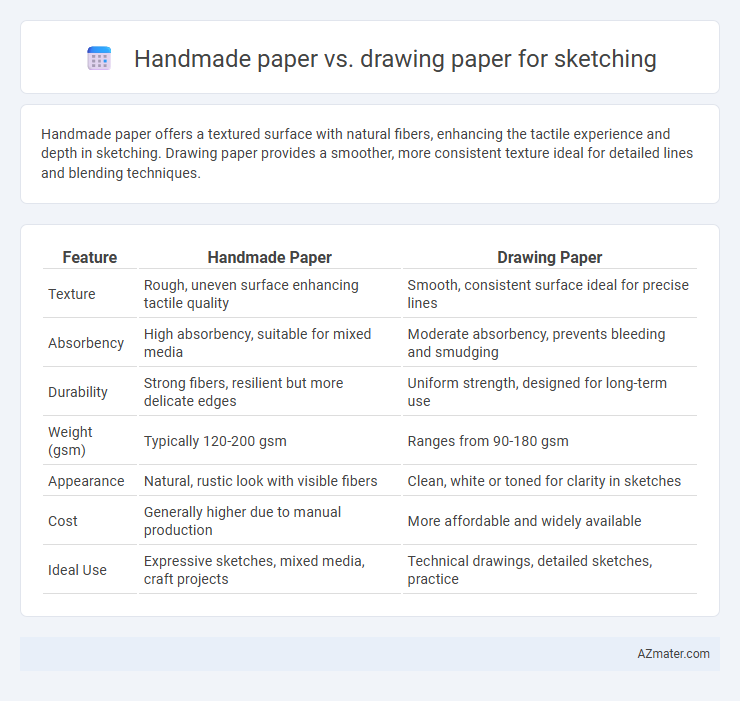Handmade paper offers a textured surface with natural fibers, enhancing the tactile experience and depth in sketching. Drawing paper provides a smoother, more consistent texture ideal for detailed lines and blending techniques.
Table of Comparison
| Feature | Handmade Paper | Drawing Paper |
|---|---|---|
| Texture | Rough, uneven surface enhancing tactile quality | Smooth, consistent surface ideal for precise lines |
| Absorbency | High absorbency, suitable for mixed media | Moderate absorbency, prevents bleeding and smudging |
| Durability | Strong fibers, resilient but more delicate edges | Uniform strength, designed for long-term use |
| Weight (gsm) | Typically 120-200 gsm | Ranges from 90-180 gsm |
| Appearance | Natural, rustic look with visible fibers | Clean, white or toned for clarity in sketches |
| Cost | Generally higher due to manual production | More affordable and widely available |
| Ideal Use | Expressive sketches, mixed media, craft projects | Technical drawings, detailed sketches, practice |
Introduction: Handmade Paper vs Drawing Paper for Sketching
Handmade paper offers a unique texture and absorbency ideal for expressive, textured sketches, providing a natural, organic feel that enhances pencil, charcoal, and ink work. Drawing paper, typically machine-made, features a smoother surface with consistent weight and durability, optimized for precision and detailed line work using pencils, pens, or markers. Choosing between handmade and drawing paper depends on the desired artistic effect, medium compatibility, and the sketch's final purpose.
What is Handmade Paper?
Handmade paper is crafted manually using natural fibers such as cotton, hemp, or recycled textile, resulting in unique textures and irregular edges that enhance artistic expression. Its absorbent surface provides a tactile experience ideal for varied media, especially charcoal, graphite, and ink sketches. Unlike drawing paper, which is machine-produced and often smoother, handmade paper offers greater durability and archival quality favored by artists seeking originality and environmental sustainability in their work.
What is Drawing Paper?
Drawing paper is a versatile, smooth surface paper specifically designed to withstand repeated erasing and layering of mediums such as graphite, charcoal, and colored pencils, making it ideal for sketching and detailed artwork. It typically features a medium weight ranging from 80 to 150 gsm, ensuring durability and sufficient texture to hold various drawing materials without excessive bleeding or smudging. Unlike handmade paper, drawing paper is machine-produced with consistent texture and quality, optimizing it for precision and clean lines in sketches.
Texture Differences: Handmade vs Drawing Paper
Handmade paper features a unique, uneven texture with visible fibers and a rough surface ideal for expressive, tactile sketches, offering rich visual depth and a natural feel. Drawing paper, typically smooth or lightly textured, provides a consistent surface that supports fine detail, precise lines, and easier pencil or ink application. Artists choose handmade paper for organic, textured effects, while drawing paper suits technical accuracy and controlled shading in sketches.
Absorbency and Medium Compatibility
Handmade paper features high absorbency due to its textured fibers, making it ideal for wet media like ink and watercolor but less suitable for precise graphite or colored pencil work. Drawing paper is smoother with lower absorbency, designed to handle dry media effectively, offering clean lines and detailed sketches without excessive bleeding or smudging. Choosing between them depends on the medium--handmade paper excels with fluid applications, while drawing paper supports controlled, fine detail.
Durability and Longevity for Artworks
Handmade paper offers superior durability for sketching due to its acid-free composition and natural fibers, ensuring artworks remain vibrant and intact over time. Drawing paper, while smooth and ideal for detailed sketches, often contains higher acidity, leading to faster yellowing and degradation. Artists seeking longevity for their artworks typically prefer handmade paper to preserve the integrity and appearance of their sketches for decades.
Environmental Impact and Sustainability
Handmade paper is crafted using traditional techniques with natural fibers, resulting in biodegradable and recyclable sheets that minimize environmental pollution, making it highly sustainable for sketching. Drawing paper, often produced through industrial processes, may involve chemical treatments and non-renewable resources, leading to a higher carbon footprint and less eco-friendly impact. Choosing handmade paper supports sustainable practices by reducing waste, conserving energy, and promoting eco-conscious artistry.
Cost Comparison: Handmade vs Drawing Paper
Handmade paper typically costs more than drawing paper due to labor-intensive production and unique textures ideal for artistic expression. Drawing paper is mass-produced, offering a cost-effective option with various weights and finishes suited for detailed sketching. Choosing between them depends on budget constraints and the desired tactile experience in sketching projects.
Best Uses for Each Paper Type in Sketching
Handmade paper offers a unique texture and absorbency ideal for expressive, mixed-media sketches where ink, charcoal, or watercolor are applied with varied pressure to create rich, organic effects. Drawing paper is smooth and specially manufactured for precision, making it perfect for detailed pencil, graphite, or pen sketches that require fine line control and uniform shading. Artists choose handmade paper for textured, experimental work and drawing paper for clean, refined sketches that demand accuracy and consistent surface quality.
Conclusion: Choosing the Right Paper for Your Sketching Needs
Handmade paper offers unique texture and absorbency, ideal for artists seeking expressive, tactile sketches with character, while drawing paper provides a smoother surface better suited for precise lines and detailed work. Choosing the right paper depends on your preferred medium--graphite, charcoal, or ink--and the desired effect, balancing texture with durability. For versatile sketching, drawing paper is often recommended, but handmade paper excels in adding depth and artistic flair to your sketches.

Infographic: Handmade paper vs Drawing paper for Sketching
 azmater.com
azmater.com